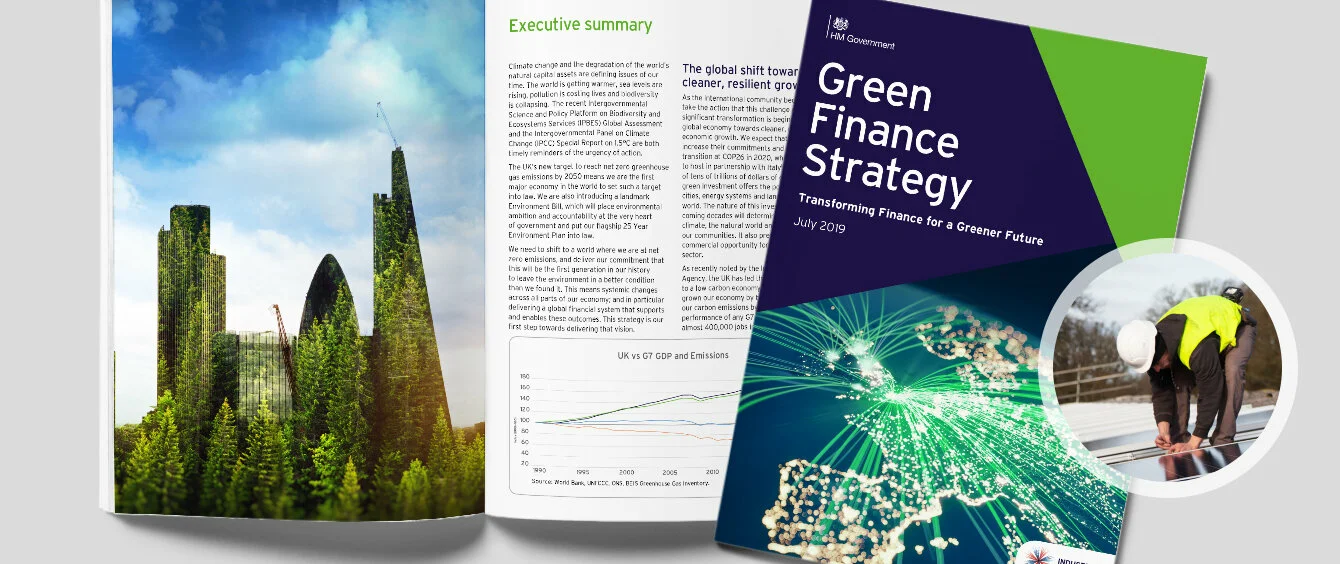
The Green Finance Strategy, published by the British government at the beginning of July, is intended to raise awareness of the need for financing according to ecological criteria.
© Crown 2019, licensed under the terms of OGL
further informationIn its report World Energy Investment 2019, published earlier this year, the International Energy Agency (IEA) wrote that there were few signs “of a major reallocation of capital required to bring [energy] investment in line with the Paris Agreement and other sustainable development goals.” It noted instead that in some areas, “investment activity in low-carbon supply and demand is stalling, in part due to insufficient policy focus to address persistent risks.”
These worrying observations highlight the problem that financial capital flows are driven by financial returns to the benefit of investors, whether a company or an ordinary citizen saving for their future, for example, through a pension fund. The focus on financial return alone fails to take into account external costs, such as damage to the environment.
Both the IEA and the UN Intergovernmental Panel on Climate Change have outlined how trillions of dollars need to be directed into clean energy technology development and deployment in coming decades, if the rise in global temperatures is to be kept to the 1.5°C increase above pre-industrial levels targeted by the Paris Climate Change Agreement.
As our understanding of climate change and the potential solutions for mitigation have evolved, it has become clear that the priorities driving financial investment flows also need to change. In other words, ‘green finance’ is needed to back sustainable growth – economic growth which provides jobs and opportunities for people without increasing greenhouse gas emissions.
Green Finance Strategy
The UK government’s publication of its Green Finance Strategy (GFS) in early July seeks to address this problem, setting out the proposals for green finance at the heart of its Clean Growth Strategy and building on the report from May 2018 of the Green Energy Taskforce, Accelerating Green Finance.
The GFS argues that the financial system must change not just to facilitate climate change mitigation efforts, but to build resilience against the risks to business that climate change poses.
It argues that this financial transformation must go beyond simply funding green energy projects to “ensuring that climate and environmental factors are fully integrated into mainstream financial decision making across all sectors and assets classes.”
This would have important implications for energy companies like RWE, which is committed to investing heavily in clean renewable energy sources such as offshore wind in the UK and elsewhere as ‘RWE Renewables’. In order to form a robust business model and drive the transformation of energy supply, RWE is taking over the renewable energy business from E.ON and innogy for a leading operating position in renewable energy. Expansion of renewable energy is assumed with net capital expenditure of around € 1.5 billion each year.
Energy companies adopt different strategies to finance clean energy projects, which include the use of capital from their own balance sheets, as well as raising project finance from financial markets.
Strategic pillars
The UK’s GFS aims to align private sector financial flows with sustainable economic growth. It has three main components:
‘Greening Finance’ proposes that by 2022 all listed companies and large asset owners disclose environmental and climate change information in line with the recommendations set out by the Task Force on Climate-Related Financial Disclosures.
In addition, it advocates the development of sustainable finance standards and calls for a clarification of the roles and responsibilities of various public bodies with regard to information disclosure. The overall aim of this component is to promote transparency, providing data and information which can then guide financial decision making.
‘Financing Green’ aims to direct private sector financial flows towards sustainable projects to support the government’s national and international environmental targets. It includes the establishment of long-term policy frameworks, improved access for finance for green investment and developing new approaches and ways of working. This element of the strategy aims to increase the opportunities for green finance by removing barriers to its deployment.
Finally, ‘Capturing the Opportunity’ aims to ensure that UK financial services benefit from the commercial opportunities presented by green finance, positioning the UK as a global hub for green financial services and products. This will include the establishment of a Green Finance Institute, which is designed to strengthen collaboration between the public and private sectors.
Marriage of priorities
The GFS is an important step in marrying financial investment priorities with the need to take long-term potentially irreversible climate change effects into account. This, in turn, should help channel the capital required into green investments like solar and offshore wind power to meet the green technology investment deficit identified by the IEA.
The UK government will review progress in these areas by the end of 2020 and a formal review of the strategy is planned for 2022.